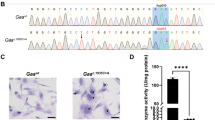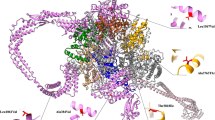Abstract
Hermansky-Pudlak syndrome (HPS; MIM 203300) is a genetically heterogeneous disorder characterized by oculocutaneous albinism, prolonged bleeding and pulmonary fibrosis due to abnormal vesicle trafficking to lysosomes and related organelles, such as melanosomes and platelet dense granules1,2,3. In mice, at least 16 loci are associated with HPS4,5,6, including sandy (sdy; ref. 7). Here we show that the sdy mutant mouse expresses no dysbindin protein owing to a deletion in the gene Dtnbp1 (encoding dysbindin) and that mutation of the human ortholog DTNBP1 causes a novel form of HPS called HPS-7. Dysbindin is a ubiquitously expressed protein that binds to α- and β-dystrobrevins, components of the dystrophin-associated protein complex (DPC) in both muscle and nonmuscle cells8. We also show that dysbindin is a component of the biogenesis of lysosome-related organelles complex 1 (BLOC-1; refs. 9–11), which regulates trafficking to lysosome-related organelles and includes the proteins pallidin, muted and cappuccino, which are associated with HPS in mice. These findings show that BLOC-1 is important in producing the HPS phenotype in humans, indicate that dysbindin has a role in the biogenesis of lysosome-related organelles and identify unexpected interactions between components of DPC and BLOC-1.
This is a preview of subscription content, access via your institution
Access options
Subscribe to this journal
Receive 12 print issues and online access
$209.00 per year
only $17.42 per issue
Buy this article
- Purchase on SpringerLink
- Instant access to full article PDF
Prices may be subject to local taxes which are calculated during checkout






Similar content being viewed by others
Accession codes
References
Dell'Angelica, E.C., Mullins, C., Caplan, S. & Bonifacino, J.S. Lysosome-related organelles. FASEB J. 14, 1265–1278 (2000).
Spritz, R.A. Multi-organellar disorders of pigmentation: intracellular traffic jams in mammals, flies and yeast. Trends Genet. 15, 337–340 (1999).
Huizing, M., Anikster, Y. & Gahl, W.A. Hermansky-Pudlak syndrome and Chediak-Higashi syndrome: disorders of vesicle formation and trafficking. Thromb. Haemost. 86, 233–245 (2001).
Novak, E.K. et al. The regulation of platelet-dense granules by Rab27a in the ashen mouse, a model of Hermansky-Pudlak and Griscelli syndromes, is granule-specific and dependent on genetic background. Blood 100, 128–135 (2002).
Suzuki, T. et al. The mouse organellar biogenesis mutant buff (bf) results from a mutation in Vps33a, a homologue of yeast vps33 and Drosophila carnation (car). Proc. Natl. Acad. Sci. USA 100, 1146–1150 (2003).
Swank, R.T., Novak, E.K., McGarry, M.P., Rusiniak, M.E. & Feng, L. Mouse models of Hermansky-Pudlak syndrome: a review. Pigment Cell Res. 11, 60–80 (1998).
Swank, R.T., Sweet, H.O., Davisson, M.T., Reddington, M. & Novak, E.K. Sandy: a new mouse model for platelet storage pool deficiency. Genet. Res. 58, 51–62 (1991).
Benson, M.A., Newey, S.E., Martin-Rendon, E., Hawkes, R. & Blake, D.J. Dysbindin, a novel coiled-coil-containing protein that interacts with the dystrobrevins in muscle and brain. J. Biol. Chem. 276, 24232–24241 (2001).
Ciciotte, S.L. et al. Cappuccino, a mouse model of Hermansky-Pudlak syndrome, encodes a novel protein that is part of the pallidin-muted complex (BLOC-1). Blood 101, 4402–4407 (2003).
Moriyama, K. & Bonifacino, J.S. Pallidin is a component of a multi-protein complex involved in the biogenesis of lysosome-related organelles. Traffic 3, 666–677 (2002).
Falcon-Perez, J.M., Starcevic, M., Gautam, R. & Dell'Angelica, E.C. BLOC-1, a novel complex containing the pallidin and muted proteins involved in the biogenesis of melanosomes and platelet-dense granules. J. Biol. Chem. 277, 28191–28199 (2002).
Blake, D.J., Hawkes, R., Benson, M.A. & Beesley, P.W. Different dystrophin-like complexes are expressed in neurons and glia. J. Cell. Biol. 147, 645–658 (1999).
Oh, J. et al. Positional cloning of a gene for Hermansky-Pudlak syndrome, a disorder of cytoplasmic organelles. Nat. Genet. 14, 300–306 (1996).
Dell'Angelica, E.C., Shotelersuk, V., Aguilar, R.C., Gahl, W.A. & Bonifacino, J.S. Altered trafficking of lysosomal proteins in Hermansky-Pudlak syndrome due to mutations in the β 3A subunit of the AP-3 adaptor. Mol. Cell 3, 11–21 (1999).
Anikster, Y. et al. Mutation of a new gene causes a unique form of Hermansky-Pudlak syndrome in a genetic isolate of central Puerto Rico. Nat. Genet. 28, 376–380 (2001).
Suzuki, T. et al. Hermansky-Pudlak syndrome is caused by mutations in HPS4, the human homolog of the mouse light-ear gene. Nat. Genet. 30, 321–324 (2002).
Zhang, Q. et al. Ru2 and Ru encode mouse orthologs of the genes mutated in human Hermansky-Pudlak syndrome types 5 and 6. Nat. Genet. 33, 145–153 (2003).
Kantheti, P. et al. Mutation in AP-3 delta in the mocha mouse links endosomal transport to storage deficiency in platelets, melanosomes, and synaptic vesicles. Neuron 21, 111–122 (1998).
Detter, J.C. et al. Rab geranylgeranyl transferase alpha mutation in the gunmetal mouse reduces Rab prenylation and platelet synthesis. Proc. Natl. Acad. Sci. USA 97, 4144–4149 (2000).
Zhang, Q. et al. The gene for the muted (mu) mouse, a model for Hermansky-Pudlak syndrome, defines a novel protein which regulates vesicle trafficking. Hum. Mol. Genet. 11, 697–706 (2002).
Huang, L., Kuo, Y.M. & Gitschier, J. The pallid gene encodes a novel, syntaxin 13-interacting protein involved in platelet storage pool deficiency. Nat. Genet. 23, 329–332 (1999).
Nguyen, T. et al. Melanosome morphologies in murine models of Hermansky-Pudlak syndrome reflect blocks in organelle development. J. Invest. Dermatol. 119, 1156–1164 (2002).
Blake, D.J., Weir, A., Newey, S.E. & Davies, K.E. Function and genetics of dystrophin and dystrophin-related proteins in muscle. Physiol. Rev. 82, 291–329 (2002).
Gardner, J.M. et al. The mouse pale ear (ep) mutation is the homologue of human Hermansky-Pudlak syndrome. Proc. Natl. Acad. Sci. USA 94, 9238–9243 (1997).
Schwab, S.G. et al. Support for association of schizophrenia with genetic variation in the 6p22.3 gene, dysbindin, in sib-pair families with linkage and in an additional sample of triad families. Am. J. Hum. Genet. 72, 185–190 (2003).
Straub, R.E. et al. Genetic variation in the 6p22.3 gene DTNBP1, the human ortholog of the mouse dysbindin gene, is associated with schizophrenia. Am. J. Hum. Genet. 71, 337–348 (2002).
Suzuki, T. et al. The gene mutated in cocoa mice, carrying a defect of organelle biogenesis, is a homologue of the human Hermansky-Pudlak syndrome-3 gene. Genomics 78, 30–37 (2001).
Reddington, M. et al. Immature dense granules in platelets from mice with platelet storage pool disease. Blood 69, 1300–1306 (1987).
Bodenteich, A., Chissoe, S., Wang, Y.F. & Roe, B.A. Shotgun cloning as the strategy of choice to generate templates for high throughput dideoxynucleotide sequencing. in Automated DNA Sequencing and Analysis Techniques 42–50 (Academic, London, 1994).
Lee, S.T., Park, S.K., Lee, K.H., Holmes, S.M. & Spritz, R.A. A non-radioactive method or simultaneous detection of single-stand conformation polymorphisms (SSCPs) and heteroduplexes. Mol. Cells 5, 668–672 (1995).
Acknowledgements
We thank D. Reddington, L. Zhen, Y. Jiang, D. Poslinski, D. Tabaczynski, M.K. Ellsworth, J. Tan, H. Chen and X. Hu for technical assistance. M. Pagan contributed to the construction of the sdy genetic map. This work was supported in part by grants from the US National Institutes of Health (R.T.S., R.W.E., R.A.S., E.C.D. and B.A.R.) and by the National Cancer Institute, US Department of Health and Human Services (N.G.C. and N.A.J.). D.J.B. is a Wellcome Trust Senior Fellow. This research used core facilities supported in part by Cancer Center Support Grant to Roswell Park Cancer Institute funded by the National Cancer Institute.
Author information
Authors and Affiliations
Corresponding author
Ethics declarations
Competing interests
The authors declare no competing financial interests.
Supplementary information
Rights and permissions
About this article
Cite this article
Li, W., Zhang, Q., Oiso, N. et al. Hermansky-Pudlak syndrome type 7 (HPS-7) results from mutant dysbindin, a member of the biogenesis of lysosome-related organelles complex 1 (BLOC-1). Nat Genet 35, 84–89 (2003). https://doi.org/10.1038/ng1229
Received:
Accepted:
Published:
Issue Date:
DOI: https://doi.org/10.1038/ng1229
This article is cited by
-
Loss of dysbindin-1 in excitatory neurons in mice impacts NMDAR-dependent behaviors, neuronal morphology and synaptic transmission in the ventral hippocampus
Scientific Reports (2024)
-
Genetic mapping of metabolic traits in the blind Mexican cavefish reveals sex-dependent quantitative trait loci associated with cave adaptation
BMC Ecology and Evolution (2021)
-
Myospryn deficiency leads to impaired cardiac structure and function and schizophrenia-associated symptoms
Cell and Tissue Research (2021)
-
Retinal biomarkers and pharmacological targets for Hermansky-Pudlak syndrome 7
Scientific Reports (2020)
-
Deletion of Dtnbp1 in mice impairs threat memory consolidation and is associated with enhanced inhibitory drive in the amygdala
Translational Psychiatry (2019)



